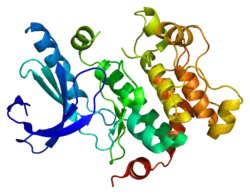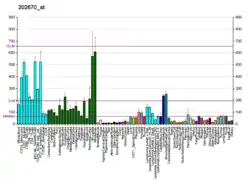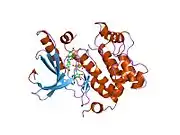MAP2K1
Dual specificity mitogen-activated protein kinase kinase 1 is an enzyme that in humans is encoded by the MAP2K1 gene.[5][6]
Function
The protein encoded by this gene is a member of the dual-specificity protein kinase family that acts as a mitogen-activated protein (MAP) kinase kinase. MAP kinases, also known as extracellular signal-regulated kinases (ERKs), act as an integration point for multiple biochemical signals. This protein kinase lies upstream of MAP kinases and stimulates the enzymatic activity of MAP kinases upon activation by a wide variety of extra- and intracellular signals. As an essential component of the MAP kinase signal transduction pathway, this kinase is involved in many cellular processes such as proliferation, differentiation, transcription regulation and development.[7] MAP2K1 is altered in 1.05% of all human cancers.[8]
Meiosis
The genomes of diploid organisms in natural populations are highly polymorphic for insertions and deletions. During meiosis double-strand breaks (DSBs) that form within such polymorphic regions must be repaired by inter-sister chromatid exchange, rather than by inter-homolog exchange. Molecular-level studies of recombination during budding yeast meiosis have shown that recombination events initiated by DSBs in regions that lack corresponding sequences in the homolog are efficiently repaired by inter-sister chromatid recombination.[9] This recombination occurs with the same timing as inter-homolog recombination, but with reduced (2- to 3-fold) yields of joint molecules.
MAP2K1 is also known as MEK1 (see Mitogen-activated protein kinase kinase). MEK1 is a meiotic chromosome-axis-associated kinase that is thought to slow down, but not entirely block, sister chromatid recombination. Loss of MEK1 allows inter-sister DSB repair and also inter-sister Holliday junction intermediates to increase. Despite the normal activity of MEK1 in reducing inter-sister chromatid recombination, such recombination still occurs frequently during normal budding yeast meiosis (although not as frequently as during mitosis), and up to one-third of all recombination events are between sister chromatids.[9]
Interactions
MAP2K1 has been shown to interact with C-Raf,[10] Phosphatidylethanolamine binding protein 1,[10] MAP2K1IP1,[11][12] GRB10,[13] MAPK3,[12][14][15][16][17] MAPK8IP3,[18][19] MAPK1[10][11][20][21][22][23] MP1,[12] and MAP3K1.[24]
References
- GRCh38: Ensembl release 89: ENSG00000169032 - Ensembl, May 2017
- GRCm38: Ensembl release 89: ENSMUSG00000004936 - Ensembl, May 2017
- "Human PubMed Reference:". National Center for Biotechnology Information, U.S. National Library of Medicine.
- "Mouse PubMed Reference:". National Center for Biotechnology Information, U.S. National Library of Medicine.
- Rampoldi L, Zimbello R, Bortoluzzi S, Tiso N, Valle G, Lanfranchi G, Danieli GA (Mar 1998). "Chromosomal localization of four MAPK signaling cascade genes: MEK1, MEK3, MEK4 and MEKK5". Cytogenet Cell Genet. 78 (3–4): 301–3. doi:10.1159/000134677. PMID 9465908.
- Zheng CF, Guan KL (Jun 1993). "Cloning and characterization of two distinct human extracellular signal-regulated kinase activator kinases, MEK1 and MEK2". J Biol Chem. 268 (15): 11435–9. doi:10.1016/S0021-9258(18)82142-1. PMID 8388392.
- "Entrez Gene: MAP2K1 mitogen-activated protein kinase kinase 1".
- "MAP2K1 - My Cancer Genome".
- Goldfarb T, Lichten M (2010). "Frequent and efficient use of the sister chromatid for DNA double-strand break repair during budding yeast meiosis". PLOS Biol. 8 (10): e1000520. doi:10.1371/journal.pbio.1000520. PMC 2957403. PMID 20976044.
- Yeung, K; Janosch P; McFerran B; Rose D W; Mischak H; Sedivy J M; Kolch W (May 2000). "Mechanism of Suppression of the Raf/MEK/Extracellular Signal-Regulated Kinase Pathway by the Raf Kinase Inhibitor Protein". Mol. Cell. Biol. UNITED STATES. 20 (9): 3079–85. doi:10.1128/MCB.20.9.3079-3085.2000. PMC 85596. PMID 10757792.
- Wunderlich, W; Fialka I; Teis D; Alpi A; Pfeifer A; Parton R G; Lottspeich F; Huber L A (Feb 2001). "A Novel 14-Kilodalton Protein Interacts with the Mitogen-Activated Protein Kinase Scaffold Mp1 on a Late Endosomal/Lysosomal Compartment". J. Cell Biol. United States. 152 (4): 765–76. doi:10.1083/jcb.152.4.765. PMC 2195784. PMID 11266467.
- Schaeffer, H J; Catling A D; Eblen S T; Collier L S; Krauss A; Weber M J (Sep 1998). "MP1: a MEK binding partner that enhances enzymatic activation of the MAP kinase cascade". Science. UNITED STATES. 281 (5383): 1668–71. Bibcode:1998Sci...281.1668S. doi:10.1126/science.281.5383.1668. PMID 9733512.
- Nantel, A; Mohammad-Ali K; Sherk J; Posner B I; Thomas D Y (Apr 1998). "Interaction of the Grb10 adapter protein with the Raf1 and MEK1 kinases". J. Biol. Chem. UNITED STATES. 273 (17): 10475–84. doi:10.1074/jbc.273.17.10475. PMID 9553107.
- Marti, A; Luo Z; Cunningham C; Ohta Y; Hartwig J; Stossel T P; Kyriakis J M; Avruch J (Jan 1997). "Actin-binding protein-280 binds the stress-activated protein kinase (SAPK) activator SEK-1 and is required for tumor necrosis factor-alpha activation of SAPK in melanoma cells". J. Biol. Chem. UNITED STATES. 272 (5): 2620–8. doi:10.1074/jbc.272.5.2620. PMID 9006895.
- Butch, E R; Guan K L (Feb 1996). "Characterization of ERK1 activation site mutants and the effect on recognition by MEK1 and MEK2". J. Biol. Chem. UNITED STATES. 271 (8): 4230–5. doi:10.1074/jbc.271.8.4230. PMID 8626767.
- Yung, Y; Yao Z; Hanoch T; Seger R (May 2000). "ERK1b, a 46-kDa ERK isoform that is differentially regulated by MEK". J. Biol. Chem. UNITED STATES. 275 (21): 15799–808. doi:10.1074/jbc.M910060199. PMID 10748187.
- Zheng, C F; Guan K L (Nov 1993). "Properties of MEKs, the kinases that phosphorylate and activate the extracellular signal-regulated kinases". J. Biol. Chem. UNITED STATES. 268 (32): 23933–9. doi:10.1016/S0021-9258(20)80474-8. PMID 8226933.
- Kuboki, Y; Ito M; Takamatsu N; Yamamoto K I; Shiba T; Yoshioka K (Dec 2000). "A scaffold protein in the c-Jun NH2-terminal kinase signaling pathways suppresses the extracellular signal-regulated kinase signaling pathways". J. Biol. Chem. UNITED STATES. 275 (51): 39815–8. doi:10.1074/jbc.C000403200. PMID 11044439.
- Ito, M; Yoshioka K; Akechi M; Yamashita S; Takamatsu N; Sugiyama K; Hibi M; Nakabeppu Y; Shiba T; Yamamoto K I (Nov 1999). "JSAP1, a Novel Jun N-Terminal Protein Kinase (JNK)-Binding Protein That Functions as a Scaffold Factor in the JNK Signaling Pathway". Mol. Cell. Biol. UNITED STATES. 19 (11): 7539–48. doi:10.1128/mcb.19.11.7539. PMC 84763. PMID 10523642.
- Sanz-Moreno, Victoria; Casar Berta; Crespo Piero (May 2003). "p38α Isoform Mxi2 Binds to Extracellular Signal-Regulated Kinase 1 and 2 Mitogen-Activated Protein Kinase and Regulates Its Nuclear Activity by Sustaining Its Phosphorylation Levels". Mol. Cell. Biol. United States. 23 (9): 3079–90. doi:10.1128/MCB.23.9.3079-3090.2003. PMC 153192. PMID 12697810.
- Robinson, Fred L; Whitehurst Angelique W; Raman Malavika; Cobb Melanie H (Apr 2002). "Identification of novel point mutations in ERK2 that selectively disrupt binding to MEK1". J. Biol. Chem. United States. 277 (17): 14844–52. doi:10.1074/jbc.M107776200. PMID 11823456.
- Xu Be, Be; Stippec S; Robinson F L; Cobb M H (Jul 2001). "Hydrophobic as well as charged residues in both MEK1 and ERK2 are important for their proper docking". J. Biol. Chem. United States. 276 (28): 26509–15. doi:10.1074/jbc.M102769200. PMID 11352917.
- Chen, Z; Cobb M H (May 2001). "Regulation of stress-responsive mitogen-activated protein (MAP) kinase pathways by TAO2". J. Biol. Chem. United States. 276 (19): 16070–5. doi:10.1074/jbc.M100681200. PMID 11279118.
- Karandikar, M; Xu S; Cobb M H (Dec 2000). "MEKK1 binds raf-1 and the ERK2 cascade components". J. Biol. Chem. UNITED STATES. 275 (51): 40120–7. doi:10.1074/jbc.M005926200. PMID 10969079.
Further reading
- Wu J, Michel H, Rossomando A, Haystead T, Shabanowitz J, Hunt DF, Sturgill TW (1992). "Renaturation and partial peptide sequencing of mitogen-activated protein kinase (MAP kinase) activator from rabbit skeletal muscle". Biochem. J. 285 (3): 701–5. doi:10.1042/bj2850701. PMC 1132850. PMID 1379797.
- Rossomando AJ, Dent P, Sturgill TW, Marshak DR (1994). "Mitogen-activated protein kinase kinase 1 (MKK1) is negatively regulated by threonine phosphorylation". Mol Cell Biol. 14 (3): 1594–602. doi:10.1128/mcb.14.3.1594-1602.1994. PMC 358518. PMID 8114697.
- Seger R, Krebs EG (1995). "The MAPK signaling cascade". FASEB J. 9 (9): 726–35. doi:10.1096/fasebj.9.9.7601337. PMID 7601337. S2CID 23298305.
- Joseph AM, Kumar M, Mitra D (2005). "Nef: "necessary and enforcing factor" in HIV infection". Curr. HIV Res. 3 (1): 87–94. doi:10.2174/1570162052773013. PMID 15638726.
- Tanaka S, Nakamura K, Takahasi N, Suda T (2006). "Role of RANKL in physiological and pathological bone resorption and therapeutics targeting the RANKL-RANK signaling system". Immunol. Rev. 208: 30–49. doi:10.1111/j.0105-2896.2005.00327.x. PMID 16313339. S2CID 13811917.
- Stove V, Verhasselt B (2006). "Modelling thymic HIV-1 Nef effects". Curr. HIV Res. 4 (1): 57–64. doi:10.2174/157016206775197583. PMID 16454711.
- Galabova-Kovacs G, Kolbus A, Matzen D, et al. (2006). "ERK and beyond: insights from B-Raf and Raf-1 conditional knockouts". Cell Cycle. 5 (14): 1514–8. doi:10.4161/cc.5.14.2981. PMID 16861903.






